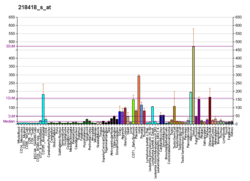| KANK2 |
|---|
|
| Available structures |
|---|
| PDB | Ortholog search: PDBe RCSB |
|---|
|
|
| Identifiers |
|---|
| Aliases | KANK2, ANKRD25, MXRA3, SIP, PPKWH, KN motif and ankyrin repeat domains 2, NPHS16 |
|---|
| External IDs | OMIM: 614610; MGI: 2384568; HomoloGene: 9163; GeneCards: KANK2; OMA:KANK2 - orthologs |
|---|
| Gene location (Human) |
|---|
 | | Chr. | Chromosome 19 (human)[1] |
|---|
| | Band | 19p13.2 | Start | 11,164,267 bp[1] |
|---|
| End | 11,197,791 bp[1] |
|---|
|
| Gene location (Mouse) |
|---|
 | | Chr. | Chromosome 9 (mouse)[2] |
|---|
| | Band | 9|9 A3 | Start | 21,678,080 bp[2] |
|---|
| End | 21,710,040 bp[2] |
|---|
|
| RNA expression pattern |
|---|
| Bgee | | Human | Mouse (ortholog) |
|---|
| Top expressed in | - saphenous vein
- gastric mucosa
- urethra
- body of uterus
- right coronary artery
- popliteal artery
- tibial arteries
- canal of the cervix
- sural nerve
- left uterine tube
|
| | Top expressed in | - ascending aorta
- interventricular septum
- aortic valve
- belly cord
- ciliary body
- sciatic nerve
- left lung lobe
- gastrula
- iris
- internal carotid artery
|
| | More reference expression data |
|
|---|
| BioGPS | 
 | | More reference expression data |
|
|---|
|
| Gene ontology |
|---|
| Molecular function | | | Cellular component | | | Biological process | - negative regulation of G1/S transition of mitotic cell cycle
- negative regulation of programmed cell death
- negative regulation of intracellular estrogen receptor signaling pathway
- negative regulation of transcription by RNA polymerase II
- negative regulation of vitamin D receptor signaling pathway
- regulation of transcription, DNA-templated
- transcription, DNA-templated
- negative regulation of cell population proliferation
- apoptotic process
- kidney epithelium development
- glomerular visceral epithelial cell migration
- regulation of Rho protein signal transduction
| | Sources:Amigo / QuickGO |
|
| Orthologs |
|---|
| Species | Human | Mouse |
|---|
| Entrez | | |
|---|
| Ensembl | | |
|---|
| UniProt | | |
|---|
| RefSeq (mRNA) | |
|---|
NM_015493
NM_001136191
NM_001329451 |
| |
|---|
| RefSeq (protein) | NP_001129663
NP_001316380
NP_056308
NP_001366477
NP_001366478
|
|---|
NP_001366479
NP_001366480
NP_001366481
NP_001366482
NP_001366483
NP_001366484
NP_001366485
NP_001366486
NP_001366487
NP_001366488
NP_001366489
NP_001366490
NP_001366491
NP_001366492 |
| |
|---|
| Location (UCSC) | Chr 19: 11.16 – 11.2 Mb | Chr 9: 21.68 – 21.71 Mb |
|---|
| PubMed search | [3] | [4] |
|---|
|
| Wikidata |
| View/Edit Human | View/Edit Mouse |
|




















